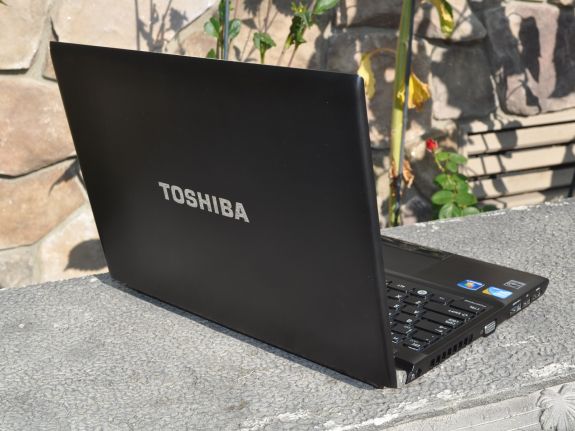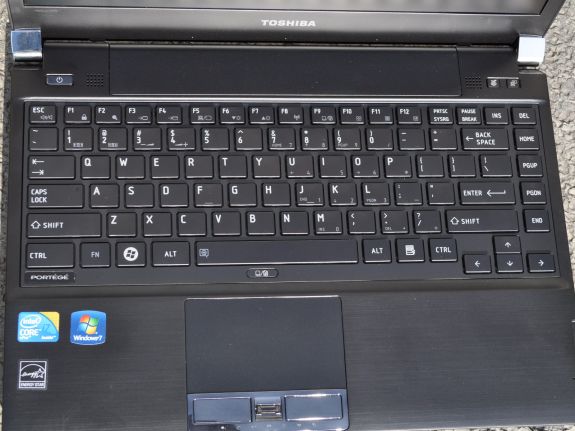Toshiba Portege R700: A Truly Ultraportable 13.3"
by Vivek Gowri on September 7, 2010 6:01 PM EST- Posted in
- Laptops
- SSDs
- Toshiba
- Portege R700
Toshiba Portege R700—Inside and Out
The R700 is definitely a good looking computer. Most of the external surfaces are rendered in black brushed magnesium, and it’s a subtle but high quality look. The large, chrome Toshiba lettering on the back is sadly not that subtle, but it does accentuate the overall aesthetic, unlike the somewhat chintzy chrome hinges. The side profile is wedge shaped and very thin throughout—the thickest point is just over an inch and slopes down from there. The surfaces are smooth and continuous, while the sides are almost entirely covered in ports. It’s not a very adventurous design, but attractive nonetheless. The overall simplicity of the aesthetic combined with the effect of the textured metal makes the entire notebook look and feel more upscale than the Toshiba name would lead you to believe.
Build quality is a more concerning item, in that it’s not very good. Even with the magnesium internal structure and the aluminum honeycomb, there’s a lot of flex present throughout the chassis. It’s especially egregious on the bottom panel, just under the optical drive, but even the palm rest on that side has a fair amount of flex. The left side of the system (which carries the HDD/SSD) feels much more solid and exhibits less flex, but that doesn’t make up for the ridiculous flex around the optical drive. The lid is fairly thin, and like most other superthin laptops, it’s not the most sturdy feeling lid and shows rippling under pressure along with being fairly flexible.
The chiclet keyboard is another issue—the feel is somewhat vague, and there is a little bit of flex at times. The flex isn’t particularly concerning and isn’t really noticeable unless you’re looking for it, but the mushy feel is pretty off-putting. To be fair, I’ve been dealing with some pretty stellar keyboards lately, with the business-class HP EliteBook 8440w and the ASUS U33Jc (in my opinion, the gold standard for consumer-level keyboards), but the Toshi keyboard is shockingly mediocre for a $1600 notebook. It looks and feels like a slightly larger version of the NB205 keyboard, which I’m not a huge fan of to start with.
The touchpad is nothing special, though the dark chrome buttons are certainly an eyesore. I’m not sure why manufacturers continue to think that putting chrome in the most touched places on a notebook is a good idea—fingerprints, hello? It’s not just Toshiba; HP was terrible (chrome touchpads and buttons?) and ASUS does the chrome mouse buttons from time to time, mostly with their Eee PC netbooks. It’s simply a bad idea. Sorry guys. There’s a fingerprint reader located between the mouse buttons, which sometimes resulted in accidental swipes and such. I prefer having the fingerprint reader off to the side like Lenovo and HP do it, but I’m guessing Toshiba liked the aesthetic of having the scanner integrated into the touchpad assembly.
The R700 has a fairly good complement of ports, with two dedicated USBs and a USB/eSATA combo port, a VGA port, HDMI, Ethernet, an SD card reader, and an ExpressCard slot located under the optical drive. Nothing spectacular or groundbreaking, but a healthy assortment for sure. The speakers are pretty poor, but that’s about par for the course as far as ultraportables go. The webcam and mic work fairly well, enough for Skype conversations. The mic is located on the palmrest, so it can be covered by a hand if you’re not paying attention.


















43 Comments
View All Comments
Jon_Irenicus - Friday, September 10, 2010 - link
I found the info and comparisons with other laptop lcds very informative. Was wondering if the same lcd review treatment could be done on an hp envy 14 with the radiance display option, and the 8740w elitebook with the dreamcolor display option seen herehttp://forum.notebookreview.com/notebook-news-revi...
In the charts posted here the vaunted rgbled display from dell blew all others away in most tests, that display is put side by side in in alienware vs the elitebooks 10 bit ips panel and it trounces it in viewing angles.
Be interesting to see how it fares on these charts with the other monitors, so far there are other panels people are not seeing in the lineup, hopefully hp can send a review unit.
TareX - Saturday, September 11, 2010 - link
So how does this compare to the 1215n? That's really what I care about.... which is better for games, and for flash HD in the browser?I4U - Saturday, October 9, 2010 - link
I'm using a cheaper version (13n) than this one you tested and the toshiba takes the place of a Thinkpad T61. I'm really delighted with the display! The color setup is excellent, the screen is really bright at maximum and the matte treatment is excellent.I don't know if the Thinkpad is really horrific, I don't know if lcd displays have made so much progress since the last 2 years, but it's for me a real pleasure to use this screen.
About the flex of the lid: the Thinkpad which is considered as really sturdy, especially for the lid has also a flex and I'm amazed Toshiba has been able to make a so sturdy device in 3lbs.
Another point: the 3G module included in the 13n version is the excellent ericsson f3607gw: 3G+, GSM, GPS and WoW (wake on wireless): with the tpm intel platform and a core i5-5xx, you get the best trusted platform available (antitheft technology).
Thank you for your wealthy analysis!